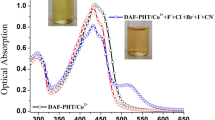Abstract
A commercially-available sulfonphthalein derivative was demonstrated to be a chemodosimeter for Fe2+ and its sensing behavior was further investigated by UV-vis spectroscopy in aqueous media under the optimum conditions. In the presence of chlorophenol red (CPR) and H2O2, the absorption maximum at 435 nm decreased upon addition of Fe2+, resulting in a significant color change of the CPR solution from yellow to colorless. The chemosensor system did not show significant responses to a series of other metal ions including Al3+, Zn2+, Cd2+, Hg2+, Mn2+, Co2+, Fe3+, Ni2+, Cu2+, La3+, Ce4+, Th4+, Pd2+, Pb2+, Sb3+, Cr3+, Au3+, Ag+, Nd3+, Sm3+, alkali and alkaline earth metal cations, allowing for highly selective naked-eye detection of Fe2+. Quantitative analysis was carried out kinetically for practicable the Fe2+ assay when either fixed time method or the initial rate method was applied. When the detecting time was set, the decrease of absorbance signal was linear with Fe2+ concentration in the range of 0 to 7.50 × 10−5 mol L−1 and the regression equation was ΔA = 0.00759 + 0.00593C Fe with a correlation coefficient r = 0.9953. The chemodosimetric system has employed an irreversible Fenton reagent-promoted oxidation of the CPR free chromophore and the hydroxyl radicals were generated in the presence of both Fe2+ and hydrogen peroxide. The mechanistic interpretation of the signaling process was partially confirmed by the radical scavenging experiment and the FT-IR analysis of the intermediates formed at different reaction periods.
Similar content being viewed by others
References
Callan JF, Silva AP, Magri DC. Luminescent sensors and switches in the early 21st century. Tetrahedron, 2005, 61: 8551–8588
Desvergne JP, Czarnik AW. Chemosensors of Ion and Molecule Recognition. Dordrecht, Netherlands: Kluwer Academic Publishers, 1997
Wang K. Trace Elements in Life Science. Beijing: Chinese Metrology Press, 1992. 415–477
Xiang Y, Tong AJ. A new rhodamine-based chemosensor exhibiting selective FeIII-amplified fluorescence. Org Lett, 2006, 8(8): 1549–1552
Bae S, Tae J. Rhodamine-hydroxamate-based fluorescent chemosensor for FeIII. Tetrahedron Lett, 2007, 48: 5389–5392
Mao J, Wang LN, Dou W, Tang XL, Yan Y, Liu WS. Tuning the selectivity of two chemosensors to Fe(III) and Cr(III). Org Lett, 2007, 9(22): 4567–4570
Wu P, Li Y, Yan XP. CdTe Quantum Dots(QDs) based kinetic discrimination of Fe2+ and Fe3+, and CdTe QDs-Fenton hybrid system for sensitive photoluminescent detection of Fe2+. Anal Chem, 2009, 81(15): 6252–6257
Stefan RI, Bairu SG. Monocrystalline diamond paste-based electrodes and their applications for the determination of Fe(II) in Vitamins. Anal Chem, 2003, 75(20): 5394–5398
Margarita S, Zlatev R, Magnin JP. Leptospirillum ferrooxidans based Fe2+ sensor. Biosensors Bioelectronics, 2009, 25(2): 482–487
Wang ZJ, Fan XJ, Li DH, Feng LH. A highly selective and colorimetric naked-eye chemosensor for Cu2+. Spectrochimica Acta Part A, 2008, 71: 1224–1227
Wang YW, Yu XM, Yu YH, Bai ZP, Shen Z, Li FY, You XZ. A colorimetric and fluorescent turn-on chemosensor for Al3+ and its application in bioimaging. Tetrahedron Lett, 2009, 50: 6169–6172
Yan LW, Yang L, Lan JB, You JS. A new perylene diimide-based colorimetric and fluorescent sensor for selective detection of Cu2+ cation. Sci Chin Ser B-Chem, 2009, 52(4): 518–522
Dujols V, Ford F, Czarnik AW. A long-wavelength fluorescent chemodosimeter selective for Cu(II) ion in water. J Am Chem Soc, 1997, 119: 7386–7387
Jimnez D, Marthnez-Mez R, Sancenn F, Soto J. A new chromochemodosimeter selective for sulfide anion. J Am Chem Soc, 2003, 125(30): 9000–9001
Yang YK, Yook KJ, Tae J. A rhodamine-based fluorescent and colorimetric chemodosimeter for the rapid detection of Hg2+ ions in aqueous media. J Am Chem Soc, 2005, 127: 16760–16761
Chung Y, Lee H, Ahn KH. N-acyl triazenes as tunable and selective chemodosimeters toward cyanide ion. J Org Chem, 2006, 71, 9470-9474
Myaji H, Sessler JL. Off-the-Shelf colorimetric anion sensors. Angew Chem Int Ed, 2001, 40(1): 154–157
Zhang X, Shiraishi Y, Hirai T. Unmodified fluorescein as a fluorescent chemosensor for fluoride ion detection. Tetrahedron Lett, 2007, 48: 8803–8006
Choi MG, Ryu DH, Jeon LJ, Cha S, Cho J, Joo HH, Hong KS. Chemodosimetric Hg2+-selective signaling by mercuration of dichlorofluorescein derivatives. Org Lett, 2008, 10(17): 3717–3720
Zelder FH. Specific colorimetric detection of cyanide triggered by a conformational switch in Vitamin B12. Inorg Chem, 2008, 47: 1264–1266
Vlasov YG, Levichev SS, Kruchinin AA, Hwang BJ. Spectroscopic study of dyes for pH and methanol sensing. Dyes Pigment, 2009, 83: 381–384
Lou XD, Li Z, Qin JG. DDTC-Na-based colorimetric chemosensor for the sensing of cyanide in water. Sci Chin Ser B-Chem, 2009, 52(6): 802–808
Walling C. Intermediates in the reactions of Fenton type reagents. Acc Chem Res, 1998, 31: 155–157
Lopez JL, Capparelli AL, Oliveros E, Hashem TM. Hydroxyl radical initiated photodegradation of 4-chloro-3,5-dinitrobenzoic acid in aqueous solution. J Photochem Photobiol A: Chem, 2000, 137: 177–184
Yu F, Xu D, Lei R, Li N, Li KA. Free-radical scavenging capacity using the Fenton reagent with rhodamine B as the spectrophotometric indicator. J Agric Food Chem, 2008, 56: 730–735
Gao HW, Chen FF, Chen L, Zeng T, Pan LT, Li JH, Luo HF. A novel detection approach based on chromophore-decolorizing with free radical and application to photometric determination of copper with acid chrome dark blue. Anal Chim Acta, 2007, 587: 52–59
Cohen B. Synthesis and indicator properties of some new sulfonphthaleins. Public Health Reports, 1926, 41: 3051–3074
White EC, Acree SF. On the quinone-phenolate theory of indicators. On the reactions of phenolsulfonphthalein, and its bromo and nitro derivatives, and their monobasic and dibasic salts. J Am Chem Soc, 1919, 41: 1190–1212
Swaminathan K, Sandhya S, Sophia C, Pachhade K. Decolorization and degradation of H-acid and other dyes using ferrous-hydrogen peroxide system. Chemophere, 2003, 50: 619–625
Peller J, Wiest O, Kamat PV. Mechanism of hydroxyl radical-induced breakdown of the herbicide 2,4-dichlorophenoxyacetic acid (2,4-D). Chem Eur J, 2003, 9: 5379–5387
Author information
Authors and Affiliations
Corresponding author
Rights and permissions
About this article
Cite this article
Zheng, K., Lai, C., He, L. et al. Chromo-chemodosimetric detection for Fe2+ by Fenton reagent-induced chromophore-decolorizing of halogenated phenolsulfonphthalein derivatives. Sci. China Chem. 53, 1398–1405 (2010). https://doi.org/10.1007/s11426-010-3170-5
Received:
Accepted:
Published:
Issue Date:
DOI: https://doi.org/10.1007/s11426-010-3170-5



